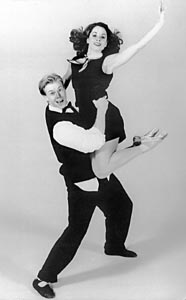![[Metroactive Stage]](/stage/gifs/stage468.gif)
[ Stage Index | San Jose | Metroactive Central | Archives ]
 Lift Zone: Mathew Gasper and Nancy Latoszewski rise to the occasion in 'Go Daddy-O!'
Lift Zone: Mathew Gasper and Nancy Latoszewski rise to the occasion in 'Go Daddy-O!'
Photograph by John Gerbetz
Swing Thing SJ Cleveland Ballet hits a dance-band groove in 'Go Daddy-O!' By Scott MacClelland DENNIS NAHAT'S Go Daddy-O! only iced the cake. Or rather set it ablaze. Smartly positioned last in the San Jose Cleveland's Evening of Premieres, it turned traditional big-band swing into a vivacious showpiece of popular music and balletic stylings. Rarely has this company hit such a level of intensity and ensemble coherence with such high speed. Of course, that's the trick. Last Friday, this fast-lane combination won the loudest audience cheers heard all season at the Center for the Performing Arts. Nahat's choreography, as exciting as it is, makes fewer technical demands of its dancers than the slower, more individual, more traditional works mounted by the company. Still, the variety of pairings, visual designs, chorus-line allusions and sheer physicality dazzled the room. Any remaining doubters were converted by Walter White's equally spectacular 19-member pit band. Costumer David Guthrie dressed all his dancers in black, white and shades of gray, while Sara Linnie Slocum's lighting painted in other colors. The original music and arrangements by Bill Duncan easily caught the flavor and flair of the 1940s. Supple spines and swinging hips gave the usual extensions and suspensions sexual energy. Arms and legs, for once, seemed the lesser of attention getters. Opening with a full corps of 12, Nahat then set four men to "Tippin' " followed by four women "Movin'." "Feelin'," the intimate centerpiece, featured company star Karen Gabay with Olivier Muñoz. The ensemble returned for "Dippin'," with Nancy Latoszewski and David Strobbe digressin' into "Ramblin'," then "Jammin' " and a reprise of "Swingin' " by the whole company. Tour de force! Saving Go Daddy-O! for last protected the remainder of the program, which made do with recorded sound and music. In Russian Blue, however, the music was a minor event compared to the choreography by Gabay. A small combo, featuring violinist Lev Polyakin, was heard in a medley of arrangements from familiar standards ("Michelle," "All of Me," "In a Sentimental Mood," "Sentimental Journey," "As Time Goes By," "Sweet Georgia Brown") while a dozen dancers gave their prima ballerina colleague an excellent product. Perhaps Gabay's most conspicuous creative fingerprint is the astonishing range of her palette. The only thing that measured up to her teeming eclecticism was the ease and grace of its execution, in all groupings and guises. There was virtually no discomfort with the material, least of all that awkwardness dancers sometimes reflect during the transition between learning and assimilating their parts. Based on discipline like this, one gets the impression that Gabay is a taskmaster--and certainly no shrinking violet. She and her popular partner, Raymond Rodriguez, danced a gorgeous duet to "As Time Goes By," giving the ballet its most personal moments. Gabay even played a humor card, a sendup of that always risible episode for four cygnets from Swan Lake. Consciously or not, Ted Shawn was the spirit behind Tom Evert's De Profundis, a sort of "to be or not to be" for nine men set to music for a cappella voices by Arvo Pärt. Slocum's lighting, mostly from the wings, etched the fine muscular conditioning of the dancers, who, per Evert's instructions, wore only Speedo-style trunks. The choreography began with a digression into pure athleticism, then developed an abstract narrative rich with expressive gesture. Strong contrasts marked the form, with long phrases following short ones and wide-open stances suddenly collapsing in on themselves. Oscar Hawkins danced his own Cris d'Enfant with Emi Hariyama and supplied his own soundtrack of voices whispering, crying out and speaking in various languages. When the two danced together, the conflicts of sex, intimacy and identity were intense. But those qualities dissipated before the piece was done, with unsatisfying results. Another company dancer, Grethel Domingo, designed Babae (the Tagalog word for woman) as a militant statement. Domingo employed pounding drums, fiery red costumes with open skirts and the five dancers' long, dark hair for a vivid display of aggressive feminism, and punctuated it with a blood-curdling shriek. [ San Jose | Metroactive Central | Archives ]
|
From the April 20-26, 2000 issue of Metro, Silicon Valley's Weekly Newspaper.
Copyright © 2000 Metro Publishing Inc. Metroactive is affiliated with the Boulevards Network.
For more information about the San Jose/Silicon Valley area, visit sanjose.com.